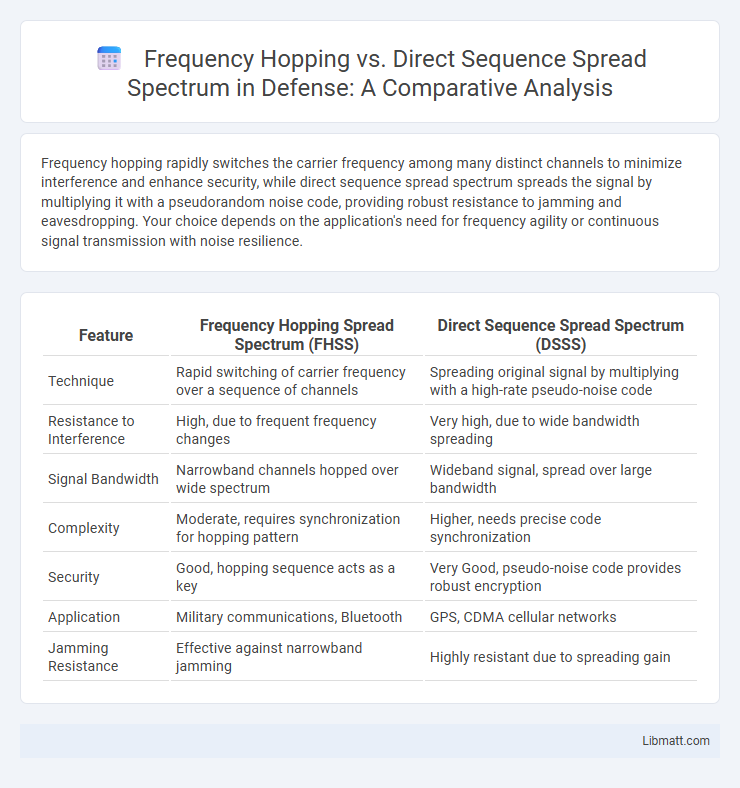Frequency hopping rapidly switches the carrier frequency among many distinct channels to minimize interference and enhance security, while direct sequence spread spectrum spreads the signal by multiplying it with a pseudorandom noise code, providing robust resistance to jamming and eavesdropping. Your choice depends on the application's need for frequency agility or continuous signal transmission with noise resilience.
Table of Comparison
| Feature | Frequency Hopping Spread Spectrum (FHSS) | Direct Sequence Spread Spectrum (DSSS) |
|---|---|---|
| Technique | Rapid switching of carrier frequency over a sequence of channels | Spreading original signal by multiplying with a high-rate pseudo-noise code |
| Resistance to Interference | High, due to frequent frequency changes | Very high, due to wide bandwidth spreading |
| Signal Bandwidth | Narrowband channels hopped over wide spectrum | Wideband signal, spread over large bandwidth |
| Complexity | Moderate, requires synchronization for hopping pattern | Higher, needs precise code synchronization |
| Security | Good, hopping sequence acts as a key | Very Good, pseudo-noise code provides robust encryption |
| Application | Military communications, Bluetooth | GPS, CDMA cellular networks |
| Jamming Resistance | Effective against narrowband jamming | Highly resistant due to spreading gain |
Introduction to Spread Spectrum Technologies
Spread spectrum technologies enhance wireless communication reliability by spreading signals over a wide bandwidth to reduce interference and improve security. Frequency hopping rapidly switches a carrier among multiple frequencies within a band, while direct sequence spread spectrum multiplies data by a pseudorandom noise code to spread the signal. Understanding these methods helps optimize your wireless system's resistance to jamming and eavesdropping in various environments.
Overview of Frequency Hopping Spread Spectrum (FHSS)
Frequency Hopping Spread Spectrum (FHSS) is a communication technique that rapidly switches the carrier frequency among multiple channels within a designated bandwidth, enhancing resistance to interference and eavesdropping. This method improves signal security and robustness by distributing the transmitted signal over various frequencies at defined time intervals. FHSS is widely used in wireless networks, including Bluetooth technology, due to its ability to minimize signal fading and reduce the impact of narrowband interference.
Overview of Direct Sequence Spread Spectrum (DSSS)
Direct Sequence Spread Spectrum (DSSS) transmits data by multiplying the signal with a high-rate pseudorandom spreading code, which increases the signal bandwidth significantly beyond the original data rate. This technique enhances resistance to interference and eavesdropping by spreading the signal energy over a wide frequency band, improving signal robustness in noisy environments. Your wireless communication benefits from DSSS through improved security and reduced susceptibility to narrowband jamming compared to frequency hopping methods.
Key Differences Between FHSS and DSSS
Frequency Hopping Spread Spectrum (FHSS) rapidly switches the carrier among many frequency channels in a pseudorandom sequence, enhancing resistance to narrowband interference and interception. Direct Sequence Spread Spectrum (DSSS) spreads the signal by multiplying data with a high-rate pseudorandom noise sequence, providing better protection against multipath fading and eavesdropping. Your choice between FHSS and DSSS depends on factors like environment, security needs, and system complexity.
Advantages of Frequency Hopping Spread Spectrum
Frequency Hopping Spread Spectrum (FHSS) provides robust resistance to narrowband interference and jamming by rapidly switching frequencies within a defined band, enhancing secure communication. Its inherent ability to minimize co-channel interference improves signal reliability in congested environments compared to Direct Sequence Spread Spectrum (DSSS). FHSS also requires lower power consumption and simpler receiver design, making it suitable for applications in military and mobile communications where efficiency and security are critical.
Advantages of Direct Sequence Spread Spectrum
Direct Sequence Spread Spectrum (DSSS) offers enhanced resistance to interference and jamming by spreading the signal across a wide frequency band, which improves signal reliability and security. It provides better coexistence with other wireless systems due to lower spectral density and can support higher data rates compared to Frequency Hopping Spread Spectrum (FHSS). Your wireless communication benefits from DSSS's robust error detection and correction capabilities, making it ideal for environments with high noise or multipath interference.
Security Implications: FHSS vs DSSS
Frequency hopping spread spectrum (FHSS) enhances security by rapidly switching frequencies within a wide band, making it difficult for eavesdroppers to intercept or jam the signal. Direct sequence spread spectrum (DSSS) spreads the signal over a wide frequency band using a pseudo-random code, offering resistance to interference and signal detection by unauthorized users. Your choice between FHSS and DSSS should consider the specific security needs, as FHSS excels in avoiding intentional jamming while DSSS provides stronger protection against signal interception and noise.
Applications and Use Cases of FHSS
Frequency Hopping Spread Spectrum (FHSS) is widely used in military communications, Bluetooth technology, and industrial wireless systems due to its robustness against interference and eavesdropping. FHSS excels in environments requiring secure, low-power communication, such as in tactical radios and wireless sensor networks. Its ability to rapidly switch frequencies makes it ideal for crowded frequency bands and enhances resistance to jamming and multipath fading.
Applications and Use Cases of DSSS
Direct Sequence Spread Spectrum (DSSS) is widely used in wireless communication systems such as Wi-Fi (IEEE 802.11b), GPS, and CDMA cellular networks due to its resistance to interference and multipath fading. It provides secure and reliable data transmission by spreading the signal over a wide frequency band, making it suitable for environments with high noise and potential eavesdropping. DSSS is favored in applications requiring robust, low-power communication with high data integrity, including satellite communication, military communications, and IoT devices.
Choosing Between FHSS and DSSS: Factors to Consider
Choosing between Frequency Hopping Spread Spectrum (FHSS) and Direct Sequence Spread Spectrum (DSSS) involves factors such as interference resistance, data rate requirements, and application environment. FHSS offers superior resistance to narrowband interference and is suitable for environments with high noise, while DSSS provides higher data rates and better security through complex spreading codes. Consider device complexity, bandwidth availability, and regulatory constraints when selecting between these two spread spectrum techniques for optimal wireless communication performance.
frequency hopping vs direct sequence spread spectrum Infographic

 libmatt.com
libmatt.com